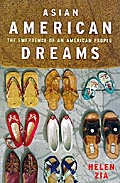By Elaine Masters
Special to the Advertiser
 |
"ASIAN AMERICAN DREAMS"
By Helen Zia, Farrar, Straus, and Giroux
|
From the title of the book and the charming cover showing lined-up Asian shoes, I thought this would be a perceptive look into the aspirations of Asian Americans. I knew it would be meaty, but I was unprepared for its depth and focus. Whenever I read a book for reviewing, I tuck in a sticky note at each major idea or turning point. This book had twice the number of stickies of any book I’ve reviewed so far.
Instead of concentrating on future goals and dreams as I expected, however, Helen Zia chronicles the smashed and altered dreams of the past.
She gives a thorough background of Asians in America from the early Chinese workers who built the western half of the first trans-continental railroad, on through the exclusionary laws which kept out immigrants from individual Asian nations. She describes how Asians swarmed in when quotas were eliminated in 1965.
The first few pages of each chapter give delightful insights into Zia’s childhood and adult life. We see the father pontificating at the dinner table on Chinese virtues, the mother pushing her children to excel, the ABCs (American Born Chinese) children rebelling and wanting to follow American customs. We see her learning the politics of protest at Princeton.
The bulk of each chapter is not so delightful, however. The first seven chapters detail case studies:
1) The Vincent Chin murder, a Chinese killed by Detroit auto workers who thought he was Japanese
2) The Family Red Apple Market grocery case in New York where a Korean grocer is victimized by the false accusations of a customer
3) Filipino workers in an Alaskan salmon cannery as they fought for equal housing and equal food
4) Korean groceries in black neighborhoods of Los Angeles, burned out in riots
5) New York South Asian taxi drivers waging a one-day strike
6) The Hawai‘i same-sex marriage debate
7) Hmong groups whose marriage customs conflict with U.S. law.
Later chapters deal with the emergence of the arts in Minneapolis with a fusion of cultures and of the Hollywood scene with Asian Americans finally getting to play Asian roles in the movies. She tells how Asian American lawyers and politicians have learned to speak up, changing the legal underpinnings of minorities.
The weakness of the book could also be its strength depending on the audience. For me, there was not enough about personal aspirations. She states that the majority of the Koreans who immigrated were college educated. Didn’t they have a dream other than working 20-hour days in a grocery?Ê And those Hmong. How did they feel about having their culture sublimated? What customs will they keep? How will they adapt?
I really didn’t want to know all about Vincent Chin. For 24 small print pages, Zia tells every conversation, court order, witness testimony, and news report available concerning the case. She does the same with the other cases. I found this tedious.
For a civics class in senior high school or a sociology course in college, however, these detailed accounts would be springboards for discussion. What were the causes of the conflict? Could it have been prevented? What was the court outcome? How did cultural misunderstanding contribute? How can this be remedied? I see great possibilities for this book with its excellent index to be used in a formal setting.
She also gives insight into the South Asian American community. She quotes Debasish Mishra, who says, "Asian Americans as a whole must re-evaluate what it means to be Asian American in order to finally stop the cycle of concentric exclusions. The alternative is that Tamils will continue to feel ignored by Sri Lankans, who are in turn tokenized by South Asian Americans, who feel marginalized by Asian Americans, who are invisible to Americans because they aren’t black or white."
Elaine Masters writes children’s books and lives in Honolulu.
[back to top] |

 The Great Index to Fun
The Great Index to Fun